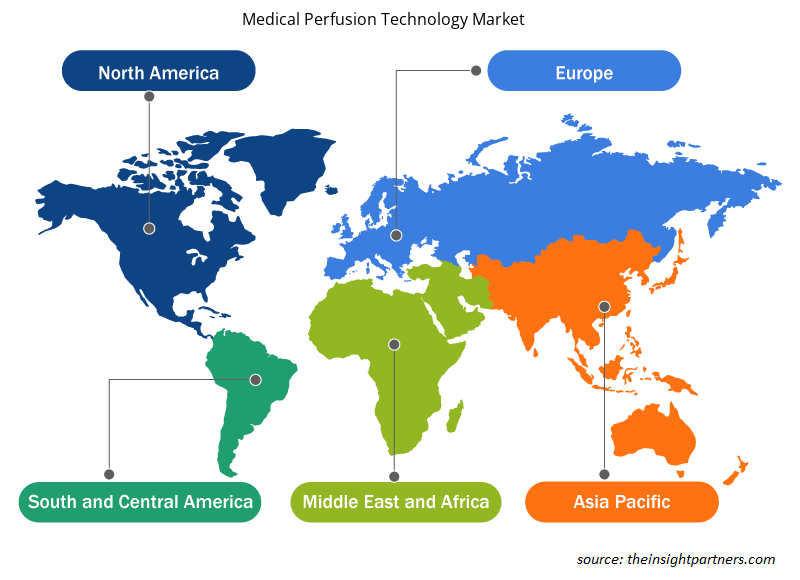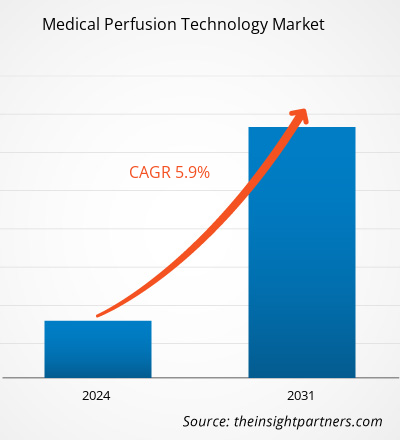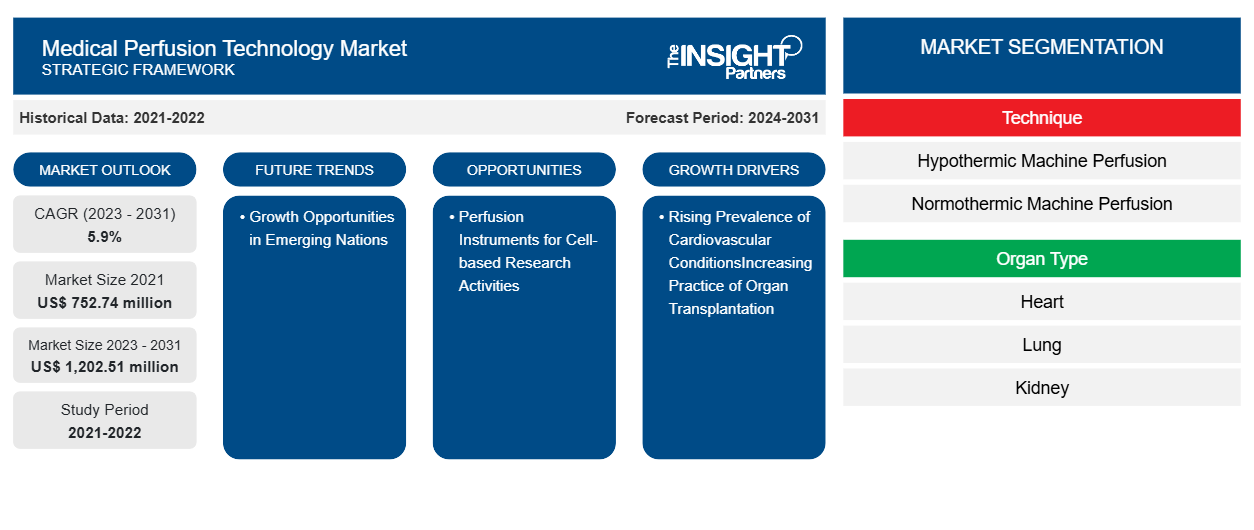2021 年医疗灌注技术市场规模为 7.5274 亿美元,预计到 2031 年将从 2023 年的 XX 百万美元增至 12.0251 亿美元。预计 2023-2031 年市场复合年增长率为 5.9%。用于细胞研究活动的灌注仪器以及紧凑型和便携式灌注机的采用可能仍是医疗灌注技术市场的主要趋势。
医疗灌注技术市场分析
冠心病、心血管病、脑血管病和风湿性心脏病等心脏病的发病率不断上升,生物技术和制药公司的大幅增长、细胞研究活动的增加以及器官移植的实践,都促进了医疗灌注技术市场的增长。此外,成熟的医疗保健行业、主要参与者的投资增加以及政府发展医疗保健行业的努力都有望推动市场增长。
医疗灌注技术市场概览
美国预计将成为最大的医疗灌注技术市场,该市场的发展归因于多种因素,例如心血管疾病的增加、全面的临床研究、合同研究等。此外,在技术方面,美国远远领先于其他发达国家和新兴国家。技术的进步导致了各种医疗灌注技术的发展以及用于其应用的技术。心脏病是美国的头号死因。当心脏动脉无法向心脏输送足够的富氧血液时,就会发生冠心病。根据疾病预防控制中心的数据,最常见的心脏病类型是冠状动脉疾病 (CAD),2021 年,美国约有 375,000 人死亡。
定制此报告以满足您的需求
您可以免费定制任何报告,包括本报告的部分内容、国家级分析、Excel 数据包,以及为初创企业和大学提供优惠和折扣
-
获取此报告的关键市场趋势。这个免费样品将包括数据分析,从市场趋势到估计和预测。
医疗灌注技术市场驱动因素和机遇
心血管疾病患病率上升有利于市场增长
心血管疾病 (CVD) 是与血管和心脏有关的疾病,包括脑血管病、风湿性心脏病和冠心病 (CHD)。心血管疾病是全球死亡的主要原因。血管的结构和功能改变主要见于老年人,这会导致心血管疾病的风险。根据美国疾病控制和预防中心 (CDC) 2020 年的数据,心脏病每年在美国导致约 695,000 人死亡。此外,根据世界卫生组织 2020 年的数据,全球约有 1790 万人死于心血管疾病。此外,大多数心血管疾病死亡是由于 CHD,其次是中风和心力衰竭。
新兴国家的增长机会
亚太、中东和非洲以及拉丁美洲等新兴地区在生物技术和制药领域发展迅速。这些地区的政府通过多项举措、计划、资金和会议提供支持。制药和生物技术的增长受到经济和人口发展、医疗支出增加以及公私医疗资金改善等因素的推动。
这些地区正在见证越来越多的初创公司,它们帮助生产仿制药、医疗器械部件的组件等。生物技术和制药领域的研发活动正在增长。新兴经济体现在正在寻求发达国家对新程序和先进技术的支持。此外,成熟的参与者正在转向新兴国家进行扩张,因为这些地区具有巨大的市场增长潜力。
医疗灌注技术市场报告细分分析
有助于得出医疗灌注技术市场分析的关键部分是技术、器官类型和组件。
- 根据技术,医疗灌注技术市场分为低温机器灌注和常温机器灌注。低温机器灌注部分在 2023 年占据了更大的市场份额。
- 根据器官类型,市场分为心脏、肺、肾、肝脏和其他。肾脏部分在 2023 年占据了最大的市场份额。
- 就组件而言,市场分为灌注泵、氧合器、心肺机、监测系统、插管等。氧合器部分在 2023 年占据了市场主导地位。
医疗灌注技术市场份额(按地区)分析
医疗灌注技术市场报告的地理范围主要分为五个区域:北美、亚太、欧洲、中东和非洲、南美和中美。
北美一直主导着医疗灌注技术市场。先进医疗灌注技术的采用率不断提高、技术进步以及对改善治疗效果的重视程度不断提高,预计将加速医疗灌注技术市场的增长。此外,加拿大心血管手术的增加以及墨西哥城心血管和哮喘的患病率不断上升,可能会在预测期内推动该地区医疗灌注技术的增长。
医疗灌注技术市场区域洞察
Insight Partners 的分析师已详细解释了预测期内影响医疗灌注技术市场的区域趋势和因素。本节还讨论了北美、欧洲、亚太地区、中东和非洲以及南美和中美洲的医疗灌注技术市场细分和地理位置。

- 获取医疗灌注技术市场的区域具体数据
医疗灌注技术市场报告范围
| 报告属性 | 细节 |
|---|---|
| 2021 年市场规模 | 7.5274亿美元 |
| 2031 年市场规模 | 12.0251亿美元 |
| 全球复合年增长率(2023 - 2031) | 5.9% |
| 史料 | 2021-2022 |
| 预测期 | 2024-2031 |
| 涵盖的领域 |
按技术分类
|
| 覆盖地区和国家 |
北美
|
| 市场领导者和主要公司简介 |
|
医疗灌注技术市场参与者密度:了解其对业务动态的影响
医疗灌注技术市场正在快速增长,这得益于终端用户需求的不断增长,而这些需求又源于消费者偏好的不断变化、技术进步以及对产品优势的认识不断提高等因素。随着需求的增加,企业正在扩大其产品范围,进行创新以满足消费者的需求,并利用新兴趋势,从而进一步推动市场增长。
市场参与者密度是指在特定市场或行业内运营的企业或公司的分布情况。它表明在给定市场空间中,相对于其规模或总市场价值,有多少竞争对手(市场参与者)存在。
在医疗灌注技术市场运营的主要公司有:
- Getinge 公司,
- 美敦力,
- LivaNova PLC,
- XVIVO 灌注,
- Terumo 心血管系统公司
- OrganOx 有限公司,
免责声明:上面列出的公司没有按照任何特定顺序排列。

- 了解医疗灌注技术市场顶级关键参与者概况
医疗灌注技术市场新闻和最新发展
医疗灌注技术市场通过收集一级和二级研究后的定性和定量数据进行评估,其中包括重要的公司出版物、协会数据和数据库。以下是医疗灌注技术市场的发展列表:
- XVIVO Perfusion AB 完成了对荷兰医疗技术公司 Organ Assist BV 全部股份的收购。Organ Assist BV Organ Assist 主要专注于开发用于肝脏和肾脏灌注的机器和耗材。通过此次收购,XVIVO 成为世界上第一家在器官保存和评估领域积极开展所有主要器官领域业务的公司。此次收购加速了该公司成为所有主要器官领域解决方案和系统的全球供应商的战略。(来源:XVIVO,新闻稿,2020 年)
医疗灌注技术市场报告覆盖范围和交付成果
“医疗灌注技术市场规模和预测(2021-2031)”报告对以下领域进行了详细的市场分析:
- 范围内所有主要细分市场的全球、区域和国家层面的市场规模和预测
- 市场动态,如驱动因素、限制因素和关键机遇
- 未来主要趋势
- 详细的 PEST/波特五力分析和 SWOT 分析
- 全球和区域市场分析涵盖关键市场趋势、主要参与者、法规和最新市场发展
- 行业格局和竞争分析,涵盖市场集中度、热点图分析、知名参与者和最新发展
- 详细的公司简介
- 历史分析(2 年)、基准年、预测(7 年)及复合年增长率
- PEST和SWOT分析
- 市场规模、价值/数量 - 全球、区域、国家
- 行业和竞争格局
- Excel 数据集
近期报告
相关报告
客户评价
购买理由
- 明智的决策
- 了解市场动态
- 竞争分析
- 客户洞察
- 市场预测
- 风险规避
- 战略规划
- 投资论证
- 识别新兴市场
- 优化营销策略
- 提升运营效率
- 顺应监管趋势























 获取免费样品 - 医疗灌注技术市场
获取免费样品 - 医疗灌注技术市场